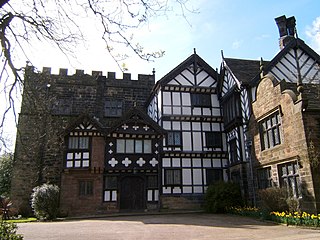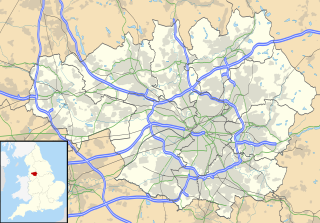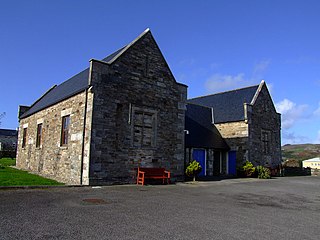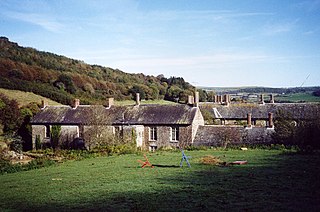Related Research Articles

The English Poor Laws were a system of poor relief in England and Wales that developed out of the codification of late-medieval and Tudor-era laws in 1587–1598. The system continued until the modern welfare state emerged after the Second World War.

In Britain, a workhouse was a total institution where those unable to support themselves financially were offered accommodation and employment. The earliest known use of the term workhouse is from 1631, in an account by the mayor of Abingdon reporting that "we have erected with'n our borough a workhouse to set poorer people to work".

A poorhouse or workhouse is a government-run facility to support and provide housing for the dependent or needy.

The Poor Law Amendment Act 1834 (PLAA) known widely as the New Poor Law, was an Act of the Parliament of the United Kingdom passed by the Whig government of Earl Grey. It completely replaced earlier legislation based on the Poor Law of 1601 and attempted to fundamentally change the poverty relief system in England and Wales. It resulted from the 1832 Royal Commission into the Operation of the Poor Laws, which included Edwin Chadwick, John Bird Sumner and Nassau William Senior. Chadwick was dissatisfied with the law that resulted from his report. The Act was passed two years after the 1832 Reform Act extended the franchise to middle class men. Some historians have argued that this was a major factor in the PLAA being passed.
A poor law union was a geographical territory, and early local government unit, in the United Kingdom and Ireland.

Turton Urban District was, from 1873 to 1974, a local government district centred on the historical area of Turton in the administrative county of Lancashire, England.

The Local Government Act 1929 was an Act of the Parliament of the United Kingdom that made changes to the Poor Law and local government in England and Wales.

The Andover workhouse scandal of the mid-1840s exposed serious defects in the administration of the English 'New Poor Law'. It led to significant changes in its central supervision and to increased parliamentary scrutiny. The scandal began with the revelation in August 1845 that inmates of the workhouse in Andover, Hampshire, England were driven by hunger to eat the marrow and gristle from bones which they were to crush to make fertilizer. The inmates' rations set by the local Poor Law guardians were less than the subsistence diet decreed by the central Poor Law Commission (PLC), and the master of the workhouse was diverting some of the funds, or the rations, for private gain. The guardians were loath to lose the services of the master, despite this and despite allegations of the master's drunkenness on duty and sexual abuse of female inmates. The commission eventually exercised its power to order dismissal of the master, after ordering two enquiries by an assistant-commissioner subject to a conflict of interest; the conduct of the second, more public inquiry drew criticism.

Bradshaw is a village of the unparished area of South Turton in the Metropolitan Borough of Bolton in Greater Manchester, England. It gives its name to the larger Bradshaw electoral ward, which includes Harwood. Historically a part of Lancashire, Bradshaw lies on the southern edge of the West Pennine Moors.
From the reign of Elizabeth I until the passage of the Poor Law Amendment Act in 1834 relief of the poor in England was administered on the basis of a Poor Law enacted in 1601. From the start of the nineteenth century the basic concept of providing poor relief was criticised as misguided by leading political economists and in southern agricultural counties the burden of poor-rates was felt to be excessive. Opposition to the Elizabethan Poor Law led to a Royal Commission on poor relief, which recommended that poor relief could not in the short term be abolished; however it should be curtailed, and administered on such terms that none but the desperate would claim it. Relief should only be administered in workhouses, whose inhabitants were to be confined, 'classified' and segregated. The Poor Law Amendment Act allowed these changes to be implemented by a Poor Law Commission largely unaccountable to Parliament. The Act was passed by large majorities in Parliament, but the regime it was intended to bring about was denounced by its critics as (variously) un-Christian, un-English, unconstitutional, and impracticable for the great manufacturing districts of Northern England. The Act itself did not introduce the regime, but introduced a framework by which it might easily be brought in.
Boards of guardians were ad hoc authorities that administered Poor Law in the United Kingdom from 1835 to 1930.

The Weaver Hall Museum and Workhouse, Northwich, Cheshire, records the social, cultural and industrial history of west Cheshire. It was formerly known as the Salt Museum, reflecting its early focus on the history of salt extraction, a local industry dating back to Roman times. The museum was renamed Weaver Hall Museum and Workhouse in 2010 as its remit now extends to cover the broader history of the area and also the history of the building itself as a former workhouse.

The Irish Poor Laws were a series of Acts of Parliament intended to address social instability due to widespread and persistent poverty in Ireland. While some legislation had been introduced by the pre-Union Parliament of Ireland prior to the Act of Union, the most radical and comprehensive attempt was the Irish act of 1838, closely modelled on the English Poor Law of 1834. In England, this replaced Elizabethan era legislation which had no equivalent in Ireland.
Newington Workhouse was a workhouse—an institution for indoor relief of the poor— at 182 Westmoreland Road,, Walworth, London, in what is now the London Borough of Southwark.

Nantwich Workhouse, also known as Nantwich Union Workhouse, Nantwich Union House and Nantwich Institution, is a former workhouse in Nantwich, Cheshire, England. It is located at The Barony, off Barony Road. Built in 1779–80 to accommodate up to 350 people, the institution remained in use as a workhouse until 1930.

Chorlton Poor Law Union was founded in January 1837 in response to the Poor Law Amendment Act 1834, also known as the New Poor Law. It was overseen by an elected board of 19 guardians representing the 12 parishes in the area it served: Ardwick, Burnage, Chorlton-upon-Medlock, Chorlton with Hardy, Didsbury, Gorton, Hulme, Levenshulme, Mosside, Rusholme, Stretford, and Withington, all in present day south Manchester, England.
In 2002, nursing homes in the United Kingdom were officially designated as care homes with nursing, and residential homes became known as care homes.

Albro Castle is a former workhouse in the north of the village of St Dogmaels, Pembrokeshire, Wales. The building was Grade II* listed in 1992 as one of the least-altered workhouses in Wales. After closing as a workhouse in 1935 the buildings were bought by Pembrokeshire County Council and in 1948 were sold into private ownership.
A Municipal hospital is a hospital under the control of a local government, as opposed to those run commercially, by some sort of charitable organisation, or by national or state governments.
The Bedwellty Union Workhouse was situated in Georgetown, Tredegar. It is 2.9 miles (4.7 km) from the Nanybwtch Junction A465. The building was in existence for approximately 127 years. The workhouse building was also used as a hospital. Today, the site where the building once stood, there is a housing estate known as St James Park.
References
- ↑ Orwell, George (1937). "Chapter 5". The Road to Wigan Pier.
- ↑ "Poor Law and Workhouse Records: Public Assistance Committee". Manchester City Council. p. 14. Archived from the original on 2011-09-29.
- ↑ "RECORDS OF THE GUARDIANS OF THE POOR OF THE MANCHESTER, CHORLTON AND PRESTWICH UNIONS". The National Archives: 127 - Manchester Archives and Local Studies. Retrieved 17 January 2021.
| | This article related to the history of the United Kingdom or its predecessor states is a stub. You can help Wikipedia by expanding it. |